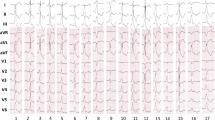Abstract
Cardiac resynchronisation therapy (CRT) by biventricular (BV) pacing is an established therapy for heart failure (HF) patients with interventricular delay (IVD), but not all patients improved clinically. The aim of the study was to evaluate directed transesophageal signal averaged electrocar diography (SAECG) for recording of right ventricular (RV) far field potential and left ventricular (LV) potential in evalua tion of IVD and LV delay (LVD) in patients with HF and left bundle branch block (LBBB).
Methods: Ten HF patients (age 69 ± 10 years; 2 females, 8 males) in NYHA class 3, 27 ± 5 % LV ejection fraction and 167 ± 20 ms QRS duration (QRSD) were analyzed IVD and LVD using directed transesophageal bipolar recording of the posterior LV wall potential with hemispherical electrodes before implantation with devices for CRT. IVD was the interval between onset of RV potential and onset of LV potential in the transesophageal SAECG. LVD was the interval between onset and offset of LV potential in the transesophageal SAECG.
Results: Recording of directed transesophageal signal averaged RV and LV potential was possible in 100% of HF patients with LBBB. Transesophageal IVD was not different than transesophageal LVD (85 ± 18 ms vs. 71 ± 20 ms, P = 0.190). Transesophageal IVD and LVD were smaller than QRSD (P < 0.001). Transesophageal IVD was not different than intracardiac RV-LV-interval between BV pacing device electrodes (85 ± 18 ms vs. 69 ± 26 ms, P = 0.144). Finite element simulation evaluated electrical cardiac pacing field.
Conclusion: Directed transesophageal LV and RV far field SAECG may detect IVD and LVD in symptomatic HF patients with LBBB before implantation of BV pacing device. Highresolution transesophageal SAECG recording may be a useful non-invasive technique to evaluate RV and LV desynchronisation in HF patients.
Access this chapter
Tax calculation will be finalised at checkout
Purchases are for personal use only
Preview
Unable to display preview. Download preview PDF.
Similar content being viewed by others
Author information
Authors and Affiliations
Editor information
Editors and Affiliations
Rights and permissions
Copyright information
© 2009 Springer-Verlag Berlin Heidelberg
About this paper
Cite this paper
Heinke, M. et al. (2009). High-Resolution Transesophageal Right Ventricular Far Field Potential and Left Ventricular Potential in Heart Failure Patients with Left Bundle Branch Block. In: Dössel, O., Schlegel, W.C. (eds) World Congress on Medical Physics and Biomedical Engineering, September 7 - 12, 2009, Munich, Germany. IFMBE Proceedings, vol 25/7. Springer, Berlin, Heidelberg. https://doi.org/10.1007/978-3-642-03885-3_212
Download citation
DOI: https://doi.org/10.1007/978-3-642-03885-3_212
Publisher Name: Springer, Berlin, Heidelberg
Print ISBN: 978-3-642-03884-6
Online ISBN: 978-3-642-03885-3
eBook Packages: EngineeringEngineering (R0)




